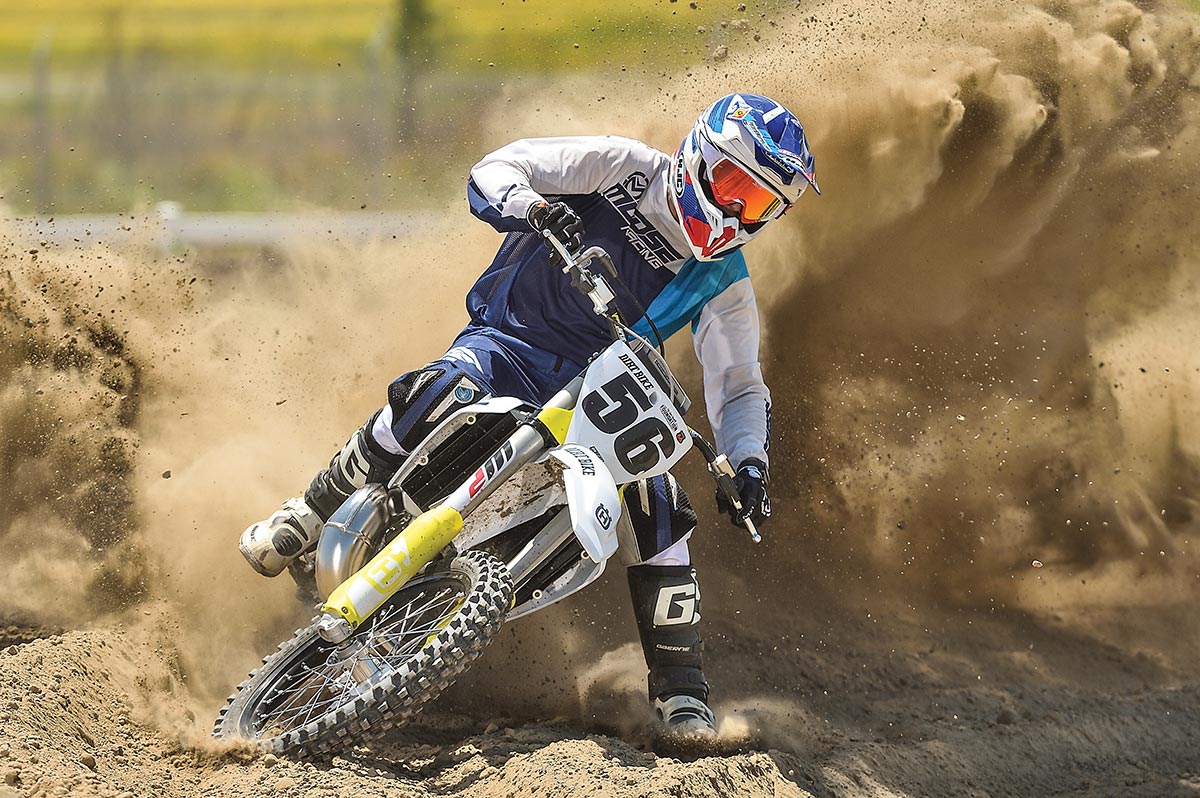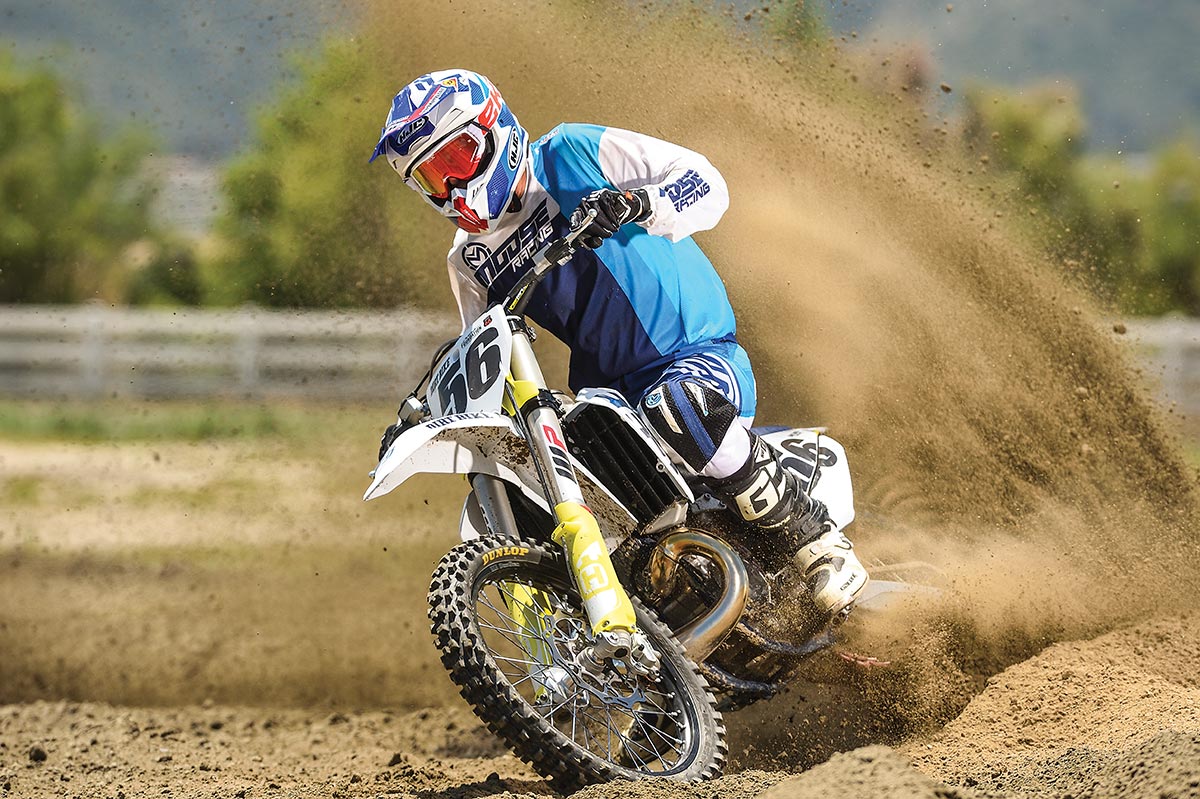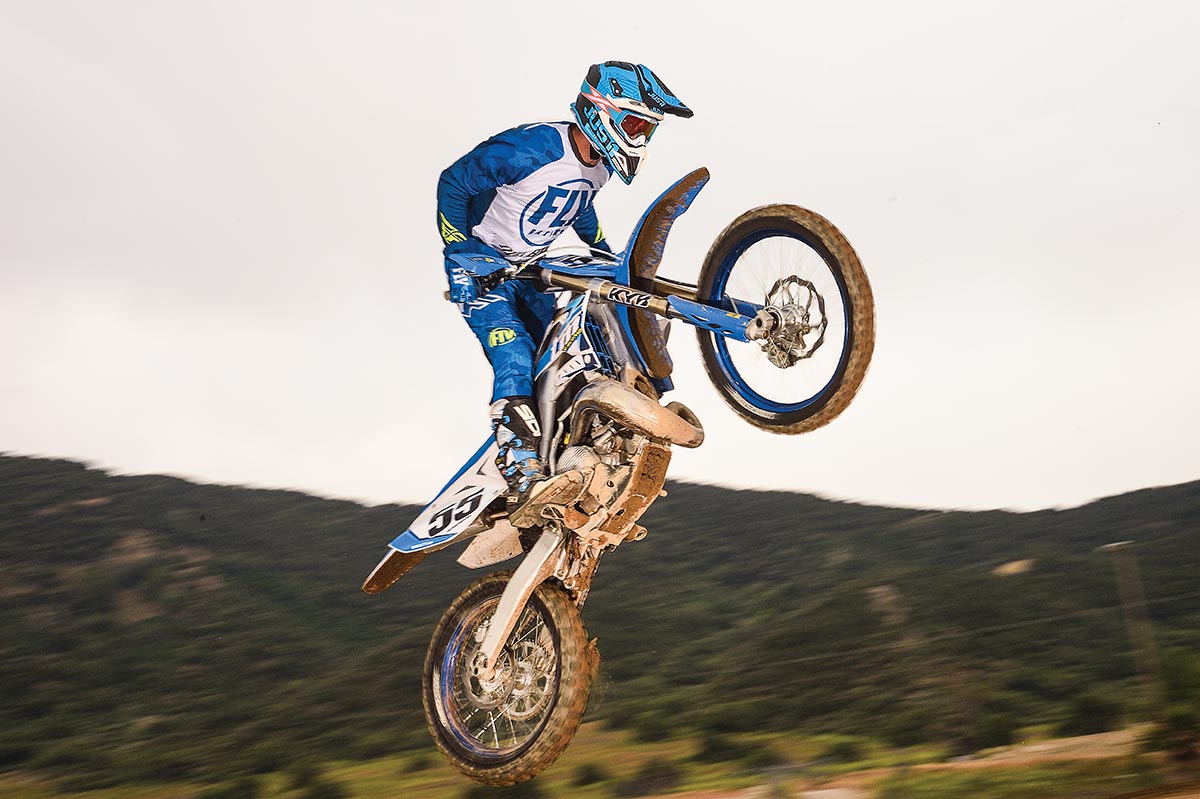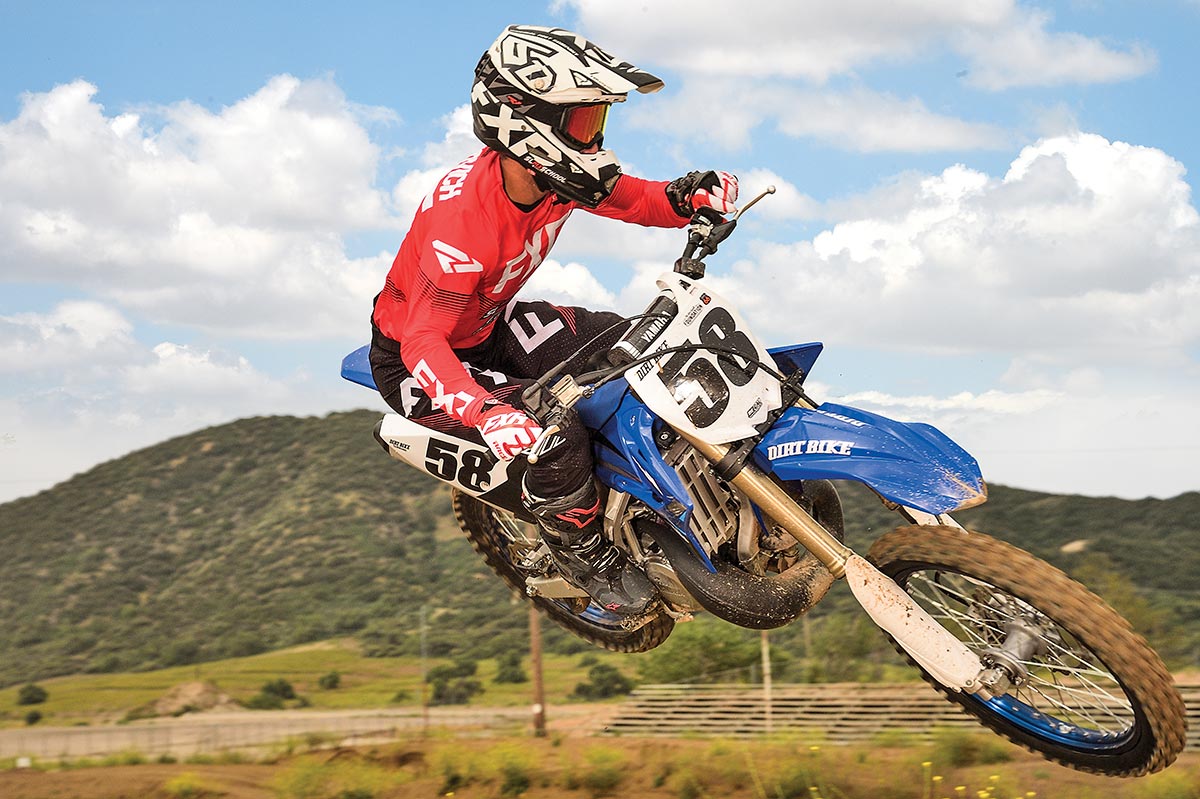The 250 two-stroke is alive and well in 2020. Austria, Japan and Italy all offer current bikes for the MX purist. Some are more modern than others, but all have suspension and brakes that we could have only dreamed of 20 years ago when the two-stroke was in its heyday. It’s time to set the four-strokes aside and compare the 2020 two-stroke motocross bikes from Husqvarna, KTM, TM and Yamaha.
HUSQVARNA TC250
Husqvarna’s first World Championship came in 1959 with Rolf Tibblin and the ancestor of this bike, the TC250. As we all know, the lineage from that bike to this one is anything but direct, but the fact remains that the Husqvarna marque is still here with the TC250 to serve the faithful. This particular bike has the engine that was redesigned with a counterbalancer in 2016. The motor didn’t look that different, but the change was obvious to anyone who rode the bikes back to back. The vibration level was reduced dramatically. What the new motor didn’t get was also interesting. The power-valve design was unchanged (still operated by a ball-ramp mechanism and adjustable through an external square-headed bolt), and it did not get electric start or fuel injection like other models in the line. Last year the bike got a more rigid frame and new bodywork. It still has a number of items that separate it from the KTM version. The Husky gets Magura hydraulic clutch components with a smaller piston in the master cylinder. It has a subframe that is integrated with the airbox, D.I.D rims and a ProTaper handlebar.

STRONG POINTS
The Husky has an incredible motor with instant response and perfect carburetion. It’s very, very fast on top, makes a ton of low-end power and is reasonably smooth. It also has a handlebar-mounted map switch that lets you calm down the power ever so slightly for low-traction situations. The Husky weighs 215 pounds without fuel, as measured on our scale. That makes it an easy bike to manhandle. When you combine that with somewhat quick handling traits, it’s a great bike for tight tracks. Other strong points are the easiest clutch pull in the group, excellent Brembo brakes and a lack of vibration.
WEAK POINTS
With so much power and so little weight, the TC250 can be a demanding bike to ride. Timing the hard-hitting powerband with the take-off ramp of a short jump requires good concentration. You can attempt to adjust the power delivery with the external adjuster, but that only seems to change when, not how hard it hits. The suspension is good, even if it’s not the best in the group.

BOTTOM LINE
Two-stroke lovers will adore the TC250. It has all the characteristics they love. It’s light, responsive and simple. It isn’t necessarily beginner-friendly, but a rider drawn to the allure of a two-stroke will probably be anything but a beginner.
KTM 250SX
If any one company can take credit for the current revitalization of the two-stroke, it’s KTM. There has never been a model year when the 250SX didn’t get the good stuff. Each time the KTM four-strokes got a new chassis or new suspension, so did the KTM two-strokes. The company’s devotion is made clear by the selection of bikes in this very test. Two of them are manufactured in the same factory—the KTM factory. Much has been written about the similarities and differences between the two makes, so it will suffice to say that the Husqvarna TC250 and the KTM 250SX differ in a handful of features, including bodywork, airboxes, subframes, clutch components, rims, seat cover and handlebars. There are slight suspension valving differences, too. Both bikes got a new counterbalancer-equipped motor in 2016 and a new frame in 2019. Both have five-speed gearboxes and Mikuni carbs. They don’t get TPI fuel injection or electric start. Those last two features, as well as the six-speed gearbox, are available on the off-road versions—the 250XC and the 250XC-W.

STRONG POINTS
Holy smokes, this bike is fast! The KTM comes on strong, hits hard and pulls like a monster. That makes it an incredibly fun ride on the right track. It’s also the lightest bike of the group, if only by 1 pound (214 pounds without fuel). The KTM’s airbox has a less-complicated design than the Husqvarna’s. It’s also a little more open and is possibly the reason for the KTM’s stronger hit. The bike handles much like the Husqvarna; it’s quick steering and super easy to manage in turns. We love the rear suspension, and we like the WP Xact air fork, which is the same model that comes on all of KTM’s and Husqvarna’s MX bikes. The one on the 250SX seems to offer more feedback (in a good way). The brakes are excellent.
WEAK POINTS
The KTM is a beast. The hard hit can be intimidating, especially on tracks with poor traction. Unlike the Husky, the 250SX has no map switch. There is a milder map pre-programmed into the ECU, but you’ll have to buy an accessory switch to access it. The KTM’s clutch pull is a little stiffer than the Husky’s. The Brembo master cylinder has a 10mm piston, whereas the Husky’s Magura master cylinder has a 9.5mm piston.

BOTTOM LINE
As you might expect, the KTM is very similar to the Husqvarna in performance. There are a handful of noticeable differences, and they all push the KTM towards the expert side of the dial. It’s just a little harder-hitting and harder-edged.
TM 250MXE
Innovation is no longer the exclusive property of big companies. Maybe it never was, but now that we have access to bikes like the TM 250MXE, that fact is clearer than ever. TM is a tiny Italian company, and yet the MXE is the most technologically sophisticated bike in this comparison. First of all, it’s the only electric-start two-stroke MX bike on the American market. It also has an electronic power valve that is far more advanced than the one that Honda was developing when it gave up on two-strokes so long ago. The TM has a counterbalancer, just like the KTM and the Husky, and even though this model has a Keihin carburetor, the company has TPI fuel injection in its bag of tricks. This is the only bike in this group with a twin-beam aluminum frame. It has a KYB fork and a rear shock that is made in-house by TM. The components are all first-class. It has a hydraulic clutch with a Brembo master cylinder, a Brembo front brake and, in an odd mix of parts, a Nissin rear brake.

STRONG POINTS
The TM is a beautifully made motorcycle. The hubs are machined from billet, as are many of the small parts. Even the frame has a hand-made look with high-quality welds–nothing done by a robot. You can’t help but like the bike as soon as you hit the starter button. It has a kick-start lever, but we never used it. The starter adds a reasonable 10 pounds to the bike’s weight; it’s 225 pounds without fuel. It still feels light. In performance, the TM has kind of an enduro-bike power delivery. It has a lot of power just above idle, then a very smooth midrange. In the upper revs it has a very strong hit. The counterbalancer shaft seems to lend the motor substantial flywheel effect. In outright speed, it’s not far from the KTM and Husky, but it has a completely different, slow-revving feel.
WEAK POINTS
The motor isn’t as strong as the others in the lower midrange, where you often find yourself in tight turns. It also free-revs slowly, so it doesn’t necessarily respond to a quick hit on the clutch. The bike has a map switch, but it doesn’t truly affect the overall character of the powerband. The motor makes considerable mechanical noise, which takes some getting used to. The suspension isn’t bad, but it feels unbalanced. The rear end feels muddy and dead, while the front is very active. You can chase it all day with clickers without making much progress. Overall comfort isn’t a strong point. The bike has a very stiff feel.

BOTTOM LINE
The TM is an off-beat bike. You have to learn its quirks and habits. If you rode nothing else, it would become your normal. In outright performance, it gives up nothing.
YAMAHA YZ250
It’s easy to disregard the YZ250 as an unchanged relic from another era. But, if you rode the 2020 YZ250 back to back with a 2005 model, you would realize how far it has come in suspension, brakes and ergos. The YZ has changed ever so gradually in significant ways. On the other hand, the big parts, meaning the frame and the motor, have gone unchanged for a very long time. We’re just lucky they were in a good place when they were frozen in time. The aluminum frame has a central backbone that many people consider the best work that Yamaha has ever done. It still has a Mikuni carb and a five-speed gearbox. You won’t see much new technology on the Yamaha: no counterbalancer, no hydraulic clutch and no electric starter.

STRONG POINTS
The Yamaha doesn’t have the most power, but it does have excellent manners. It’s very crisp and responsive, with excellent output in the lower midrange, right where you need it most. It also revs a little more controllably than the KTM or Husky, so it’s easy to use partial-throttle openings to deal with poor traction. The Yamaha is the most stable of the four in a straight line. It’s predictable and never does anything that you don’t see coming from a long way away. In true Yamaha fashion, it has the most trouble-free suspension. This is basically the same fork used on the current four-stroke Yamaha MXers, and it is outstanding.
WEAK POINTS
In outright acceleration, the Yamaha is the slowest of the four, if only by a small margin. It also vibrates the most. That’s a sign of the times; at one time we considered this motor to be nearly vibration-free. Standards change. In overall handling, too, the Yamaha has an old-school feel. The others all have quicker steering. We can’t really say this is a weak point, because we’re still fans of this particular era in motorcycle frame design, but riders who have come of age in recent years might think the YZ250 has a vintage feel. The cable-actuated clutch has a stiffer pull than the others, and the brakes are just adequate. The YZ250 weighs 218 pounds without fuel.

BOTTOM LINE
The YZ has weathered the years well. It always had a great motor, and Yamaha was smart to keep updating the suspension year after year. That allows the bike to go wheel to wheel with more modern bikes. Veteran riders will still love the YZ250, even though its age is showing. At the end of the day, it’s a little slower, a little heavier and a little more dated than the others.
PLANET TWO-STROKE
When two-strokes overthrow the world, this will be the pecking order
We’re not here to choose the best motocross bike in the world. That’s been tried many times. But, the two-stroke-versus-four-stroke winner will continue to be hard to call. This is more straightforward. In a world ruled by two-strokes, who will sit on top?
FIRST PLACE: HUSQVARNA TC250
In a very cool circle of motocross life, the original king of motocross has returned to claim the throne. The Husky is very much a modern motorcycle. The motor is as up to date as anything in the four-stroke world. It has current features such as a hydraulic clutch and a counterbalancer. It’s crisp and smooth. It’s light and fast. The Husqvarna has everything that the two-stroke faithful demand and enough outright performance to draw outsiders into the fold.
SECOND PLACE: KTM 250SX
The people aboard the KTM mothership know exactly what they’re doing. There’s just enough difference between the KTM 250SX and the Husqvarna TC250 to appeal to a different crowd. The KTM is a little more aggressive, making it the bike most likely to end up in a pro race. In 2019 it was the only two-stroke to qualify for an outdoor national. The only reason that it finished behind the Husky here is because the slightly (very slightly) more conservative nature of the TC250 is a better match for the ready-made two-stroke fan base.
THIRD PLACE: YAMAHA YZ250
Beware of anyone who doesn’t like the YZ250. He’s probably a serial killer or some other dangerous misanthrope. This is a fun motorcycle without serious flaws. Time has caught up to it in outright performance, but it’s still a wonderful motorcycle. The fact that it’s still here for us to test and enjoy almost 20 years after its initial design is a testimony to its quality.
FOURTH PLACE: TM 250MXE
We’re stunned by the overall workmanship of the TM. We don’t understand how a small company like this can battle KTM and Yamaha to a standstill, but it’s impressive. In the end, the TM remains a very off-beat motorcycle that was never intended for the masses. It’s a little bit heavier and a little bit more expensive than the other bikes in the group. Still, if you’re looking for an electric-start two-stroke motocross bike, it’s the only one.






Comments are closed.